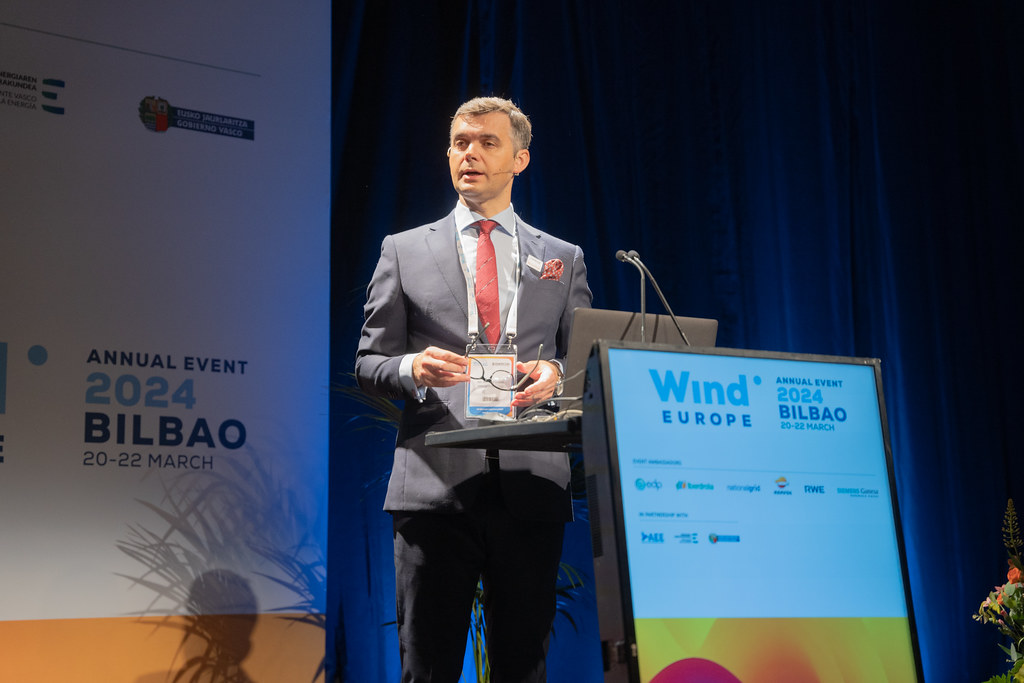On 20-22 March the ETIPWind project participated in WindEurope’s annual event in Bilbao. The event gathered more than 12,000 participants including policymakers and professionals from all the segments of the wind supply chain. This was the perfect opportunity to present the wind industry’s R&I priorities to the whole wind energy community and to discuss how R&I can support the competitiveness of the European wind energy sector.
ETIPWind’s conference session
The first day of the WindEurope’s conference was marked by the session organised by ETIPWind on a strategic agenda for wind Research & Innovation (R&I). Moderated by Adrian Timbus – ETIPWind Chair, the session addressed the short-term R&I priorities that will be critical to accelerate wind energy deployment in Europe.
Hanif Mashal (CEO, LM Wind Power) introduced the session by tackling the challenge of scaling up to mass production: “In Europe we have been in the forefront of the wind turbine performance, cost-effectiveness, and reliability. There has been a lot of innovation in these fields. We now need to invest in manufacturing, production lines and transport and installation to keep our leadership.”
Hanif was followed by Bernd Biervert (Head of Unit “Clean energy transitions”, DG Research & Innovation) from the European Commission who highlighted the importance of wind energy in the delivery of the EU energy and climate targets: “There is a sense of urgency, we need to act now. We need to speed-up, we need to scale and for that the role of Research & Innovation is very important”.
During the keynote speeches and panel discussions, we also launched the official presentation video of the Strategic Research & Innovation Agenda.
Hanif Mashal (CEO, LM Wind Power), Federico Gonzalez (Regional CTO, Vestas), Celine Mahieux (VP Power Technology and Innovation Excellence, Shell), and Katherine Dykes (Head of Center, DTEC) then provided their insights on the main R&I priorities during a panel discussion. They emphasised how innovations in manufacturing, turbine design, recycling, digitalisation, or system integration can support the scale-up of the wind industry. And therefore accelerate the mass production of volumes that Europe needs.
The discussion ended with four recommendations from the panellists to the national governments:
- Protect the European wind energy manufacturing footprint;
- Accelerate permitting of wind energy projects, new factories and facilities;
- Improve the supporting / funding mechanisms for wind energy; and
- Accelerate the build-out and the upgrade of grid infrastructures.
ETIPWind Steering Committee meets with the CTOs
.jpg)
Later in the afternoon, ETIPWind’s members of the Steering Committee and ten Chief Technology Officers (CTOs) reunited, mainly to discuss their advocacy strategy and the dissemination of the ETIPWind Strategic R&I Agenda. The main highlights from the meeting are summarised below:
Bernd Biervert shared insights on the next Horizon Europe Work Programme and discussed with the experts the most urgent wind energy Research & Innovation topics to be addressed. This discussion was very timely as the European Commission is currently defining the next calls for proposals of the Horizon Europe Work Programme 2025.
Hanne Wigum (Leader Offshore Wind Concepts at Equinor) and Stephan Barth (Managing Director at ForWind – Center for Wind Energy Research) were elected as new Vice Chairs of the Steering Committee with more than 95% of the votes. They will help the ETIPWind Chair to guide the platform’s work and to disseminate the wind industry’s R&I priorities in Europe.
Ignacio Marti Perez Marti (EERA JP Wind’s Director) presented the new EERA’s long term research programme. The document was developed in line with ETIPWind’s Strategic R&I Agenda and sets long-term wind energy research needs until 2050. It will soon be published on the EERA’s JP Wind website.
Finally, a dedicated session on EUprojects gathered the industry partners of three projects:
- the BLADES2BUILD project, focusing on blade recycling and demonstration of recycling processes;
- the InterOPERA project, focusing on developing the first European multi-terminal, multi-vendor HVDC system; and
- the ReaLCoE project, focusing on offshore wind energy converters on a 12+MW demonstration turbine.
They shared their experience in EU Projects and highlighted the benefits for the industry to involve in such Consortiums.

